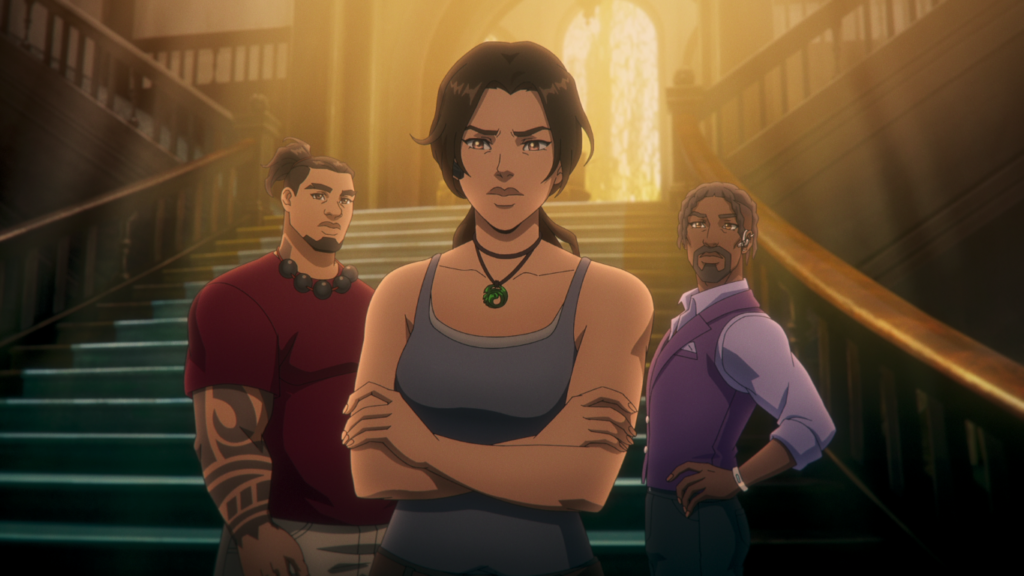Tomb Raider: The Legend of Lara Croft was set to be a winning recipe: Lara Croft, recently voted the most iconic video game character of all time, meets Powerhouse Animation, the Texas-based studio behind immaculate animated projects such as Castlevania, Blood of Zeus, and Kevin Smith’s Masters of the Universe. In large part, it succeeds, giving audiences a detailed, compelling take on Croft that feels thunderously fresh. But, it doesn’t quite deliver on all fronts.
★★★☆☆
Picking up after the events of Crystal Dynamics’ Survivor Trilogy, Croft (voiced by Hayley Atwell) has overcome unthinkable odds but remains haunted by loss. This leads her to retreat into herself, keeping friends such as Jonah (voiced by Earl Baylon) and Zip (voiced by Allen Maldonado) at arm’s length. However, following a theft from her family mansion, Croft once again swings into action, uncovering relics and secrets across the globe to prevent the world from slipping into a state of violent chaos. While doing so, her friendships – old and new – are tested like never before, and Croft has to try and prove she is still the person she wants to be without grief and anger fuelling the fire that burns inside of her.
This latest version of Lara Croft feels a million miles away from her debut as a sexually titillating instance of wayward geometry. Tiny waists and big breasts are out, and in their place is a woman carved from stone. Her muscularity, agility, and strength are clearly sensational but not quite bordering beyond reason (particularly by animation standards). Her trademark somersaults and leaps remain, needlessly so in too many cases, but regardless this looks and feels like the Lara Croft viewers deserve—an Indiana Jones-inspired feminine icon with the power to boot.
It is not her physical strength that comes under the most examination though. It is her mental resilience. There’s a bullishness and defensiveness about Croft that didn’t exist before. Compared to the Survivor Trilogy, there is a more forceful examination of her weaknesses and morals, and she is forced to find strength in her vulnerability around others—quite a change from taking on tigers with handguns and popping bad guys like they’re candy. The villainous Charles Devereaux (played with charm and delicious malice by Castlevania veteran Richard Armitage) embodies these insecurities, at once a dark reflection of Croft and a villainous spin on significant figures from her past. It is the pair’s compelling villainy that enables such a deep and mindful examination of Croft’s character.

Croft’s relationships with those around her give the series a more personal, emotional feel than the games can consistently handle. But you’d be mistaken for thinking this is even close to a hard reset. The Legend of Lara Croft wears the legacy and popularity of the games on its sleeve, everything from the environment (“Spiked pit. Classic”), to some sound effects borrowed from the games and the rip-roaring pursuits across collapsing buildings and terrain. The series also follows Shadow of the Tomb Raider (2018) in having a more tense relationship between Croft and Jonah, with the latter challenging Lara’s frame of mind throughout. Sometimes this reliance on the games can prove frustrating. Unlike other series like Arcane for example, too much of the worldbuilding in The Legend of Lara Croft relies on prior knowledge. Without this, the narrative and emotional impact of certain scenes can become lost.
Unusually for Powerhouse, the series doesn’t seem to match the Lara Croft games on the action front. Compared to the unassailably high bar they set with Castlevania, here the choreography feels repetitive and the action less free-flowing or kinetic. The final confrontation with Devereaux meanwhile dissolves into a 1990s-style boss fight that feels less like a homage and more like a slapped-together finale. The animation too, compared to the rich detail of other Powerhouse projects, never feels quite there, unhelpfully burdened perhaps by Crystal Dynamics’ exceptional work in rendering the world of Tomb Raider with staggering detail over the past decade. Powerhouse also clearly leans into their horror chops with a more immediately supernatural and fantastical take on Tomb Raider, which can look impressive but risks feeling out of place when unleashed too early into proceedings.

Fortunately, most of these grievances are overshadowed by the central story, a story that suggests while Crystal Dynamics’ games are at an end, Croft’s crafting into a hardened survivor is just beginning. While imperfect, The Legend of Lara Croft continues the character’s immaculate reinvention and moves towards the emotional richness that fans deserve. It isn’t clear where Croft’s next adventures will take her, but it will almost certainly be another extraordinary adventure.
Stream season one of Tomb Raider: The Legend of Lara Croft on Netflix now.
Words by James Hanton
Support The Indiependent
We’re trying to raise £200 a month to help cover our operational costs. This includes our ‘Writer of the Month’ awards, where we recognise the amazing work produced by our contributor team. If you’ve enjoyed reading our site, we’d really appreciate it if you could donate to The Indiependent. Whether you can give £1 or £10, you’d be making a huge difference to our small team.
